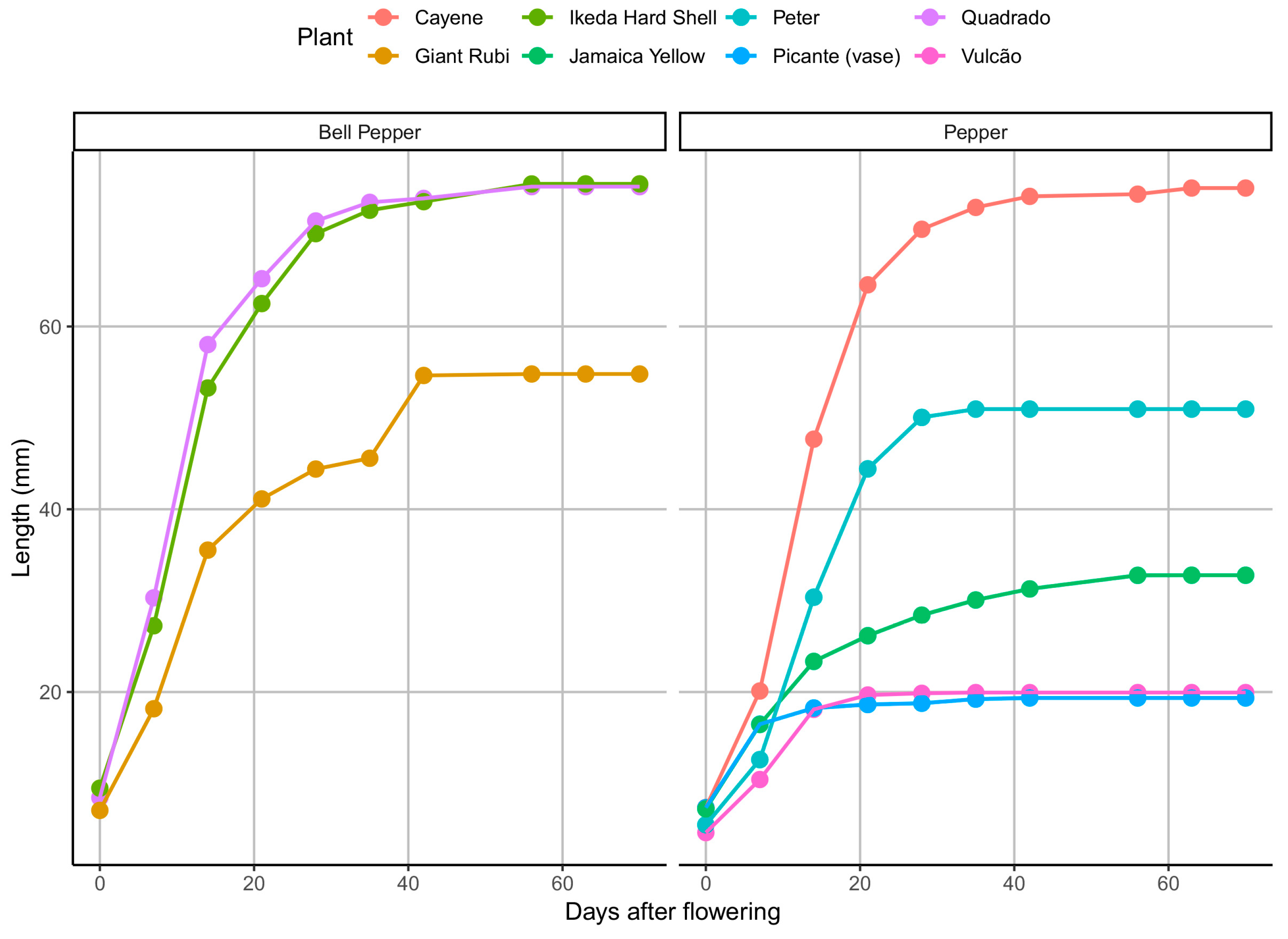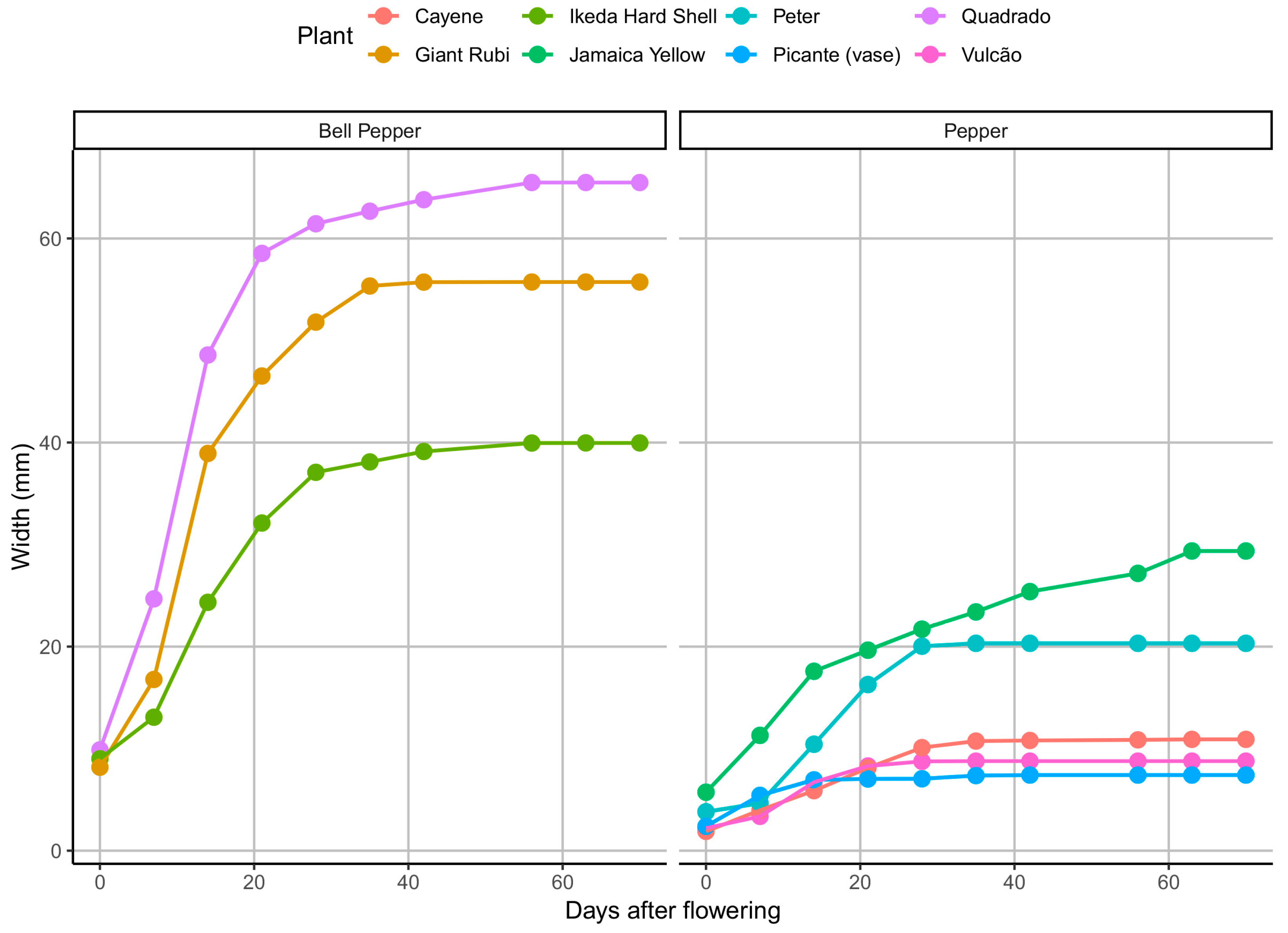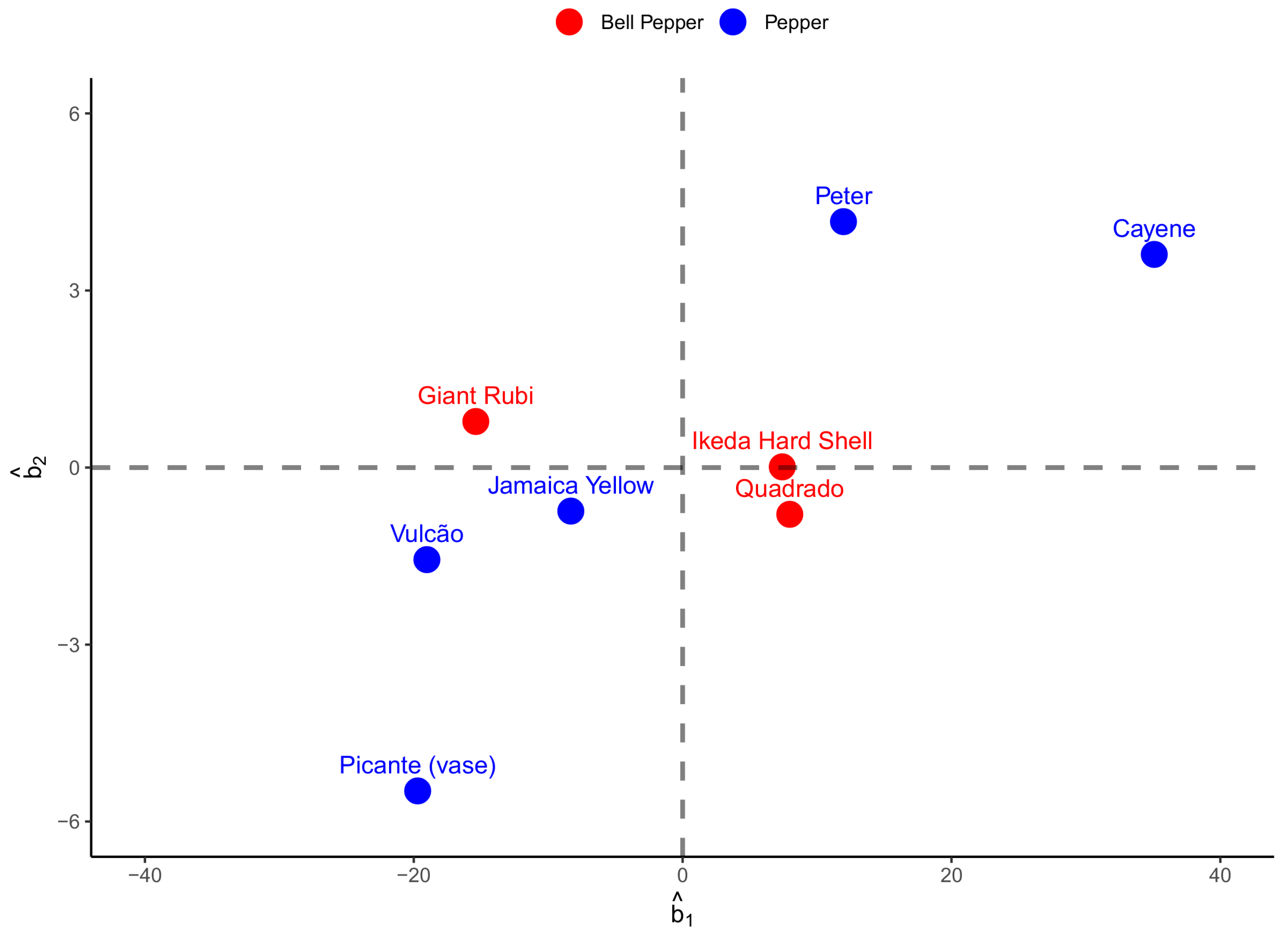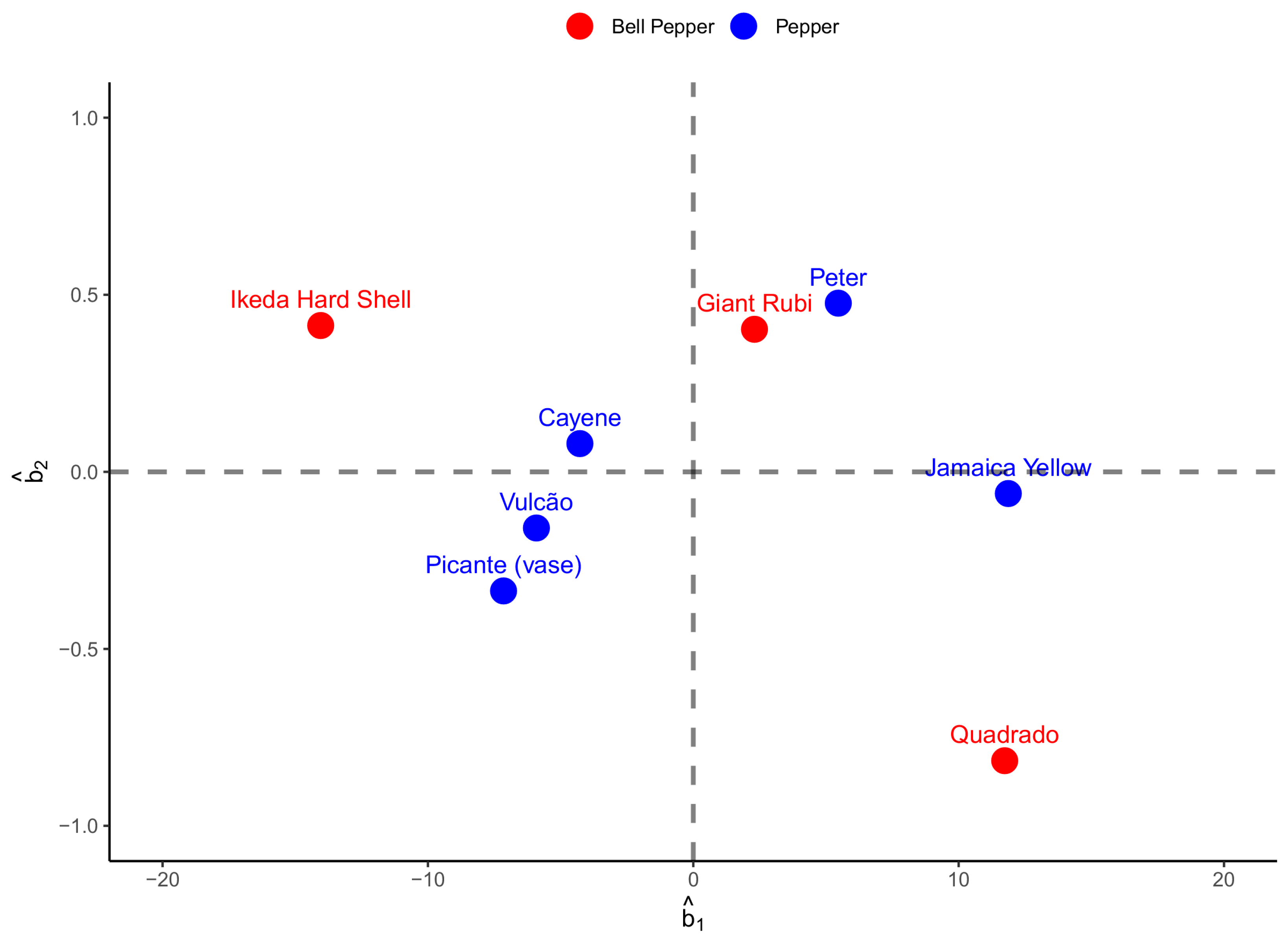Nonlinear Mixed-Effect Models to Describe Growth Curves of Pepper Fruits in Eight Cultivars Including Group Effects
Abstract
1. Introduction
- (i)
- compare the non-linear models of Gompertz, Logístic, Richards, and von Bertalanffy using NLME to fit the length- and width-growth data of pepper and bell pepper fruits, both inserted as covariates (fixed effects), where, for each model, measures of goodness of fit will be calculated and the best fits for each characteristic will be identified;
- (ii)
- identify the growth patterns in each group according to the estimation of the fixed effects (pepper and bell pepper) and
- (iii)
- verify the correlations between the biological interpretable growth variables, evaluated individually by the random effects of the models.
2. Materials and Methods
2.1. Description of the Experiment
2.2. Nonlinear Mixed-Effect Models
2.3. Equations to Represent
2.4. Fit Comparison
2.5. Computational Tools
3. Results
4. Discussion
5. Conclusions
Author Contributions
Funding
Data Availability Statement
Acknowledgments
Conflicts of Interest
References
- Sobczak, A.; Kucko, A.; Pióro-Jabrucka, E.; Gajc-Wolska, J.; Kowalczyk, K. Effect of Salicylic Acid on the Growth and Development of Sweet Pepper (Capsicum annum L.) under Standard and High EC Nutrient Solution in Aeroponic Cultivation. Agronomy 2023, 13, 779. [Google Scholar] [CrossRef]
- Zhang, Y.J.; Gan, R.Y.; Li, S.; Zhou, Y.; Li, A.N.; Xu, D.P.; Li, H.B. Antioxidant phytochemicals for the prevention and treatment of chronic diseases. Molecules 2015, 20, 21138–21156. [Google Scholar] [CrossRef] [PubMed]
- Zaki, N.; Hasib, A.; Eddine, K.C.; Dehbi, F.; El Batal, H.; Ouatmane, A. Comparative Evaluation of the Phytochemical Constituents and the Antioxidant Activities of Five Moroccan Pepper Varieties (Capsicum Annuum L.). JCBPS 2017, 7, 1294–1306. [Google Scholar]
- Sanati, S.; Razavi, B.M.; Hosseinzadeh, H. A review of the e_ects of Capsicum annuum L. and its constituent, capsaicin, in metabolic syndrome. Iran. J. Basic Med. Sci. 2018, 21, 439–448. [Google Scholar]
- Rêgo, E.R.; Rêgo, M.M.; Finger, F.L. Production and Breeding of Chilli Peppers (Capsicum app.), 1st ed.; Springer International Publishing: Cham, Switzerland, 2016; p. 146. [Google Scholar]
- Oliveira, A.C.R.; Cecon, P.R.; Puiatti, G.A.; Guimarães, M.E.S.; Cruz, C.D.; Finger, F.L.; Nascimento, M.; Puiatti, M.; Lacerda, M.S. Nonlinear models based on quantiles in the fitting of growth curves of pepper genotypes. Rev. Bras. Biom. 2021, 39, 447–459. [Google Scholar] [CrossRef]
- Wubs, A.M.; Ma, Y.T.; Heuvelink, E.; Hemerik, L.; Marcelis, L.F. Model Selection for Nondestructive Quantification of Fruit Growth in Pepper. J. Amer. Soc. Hort. Sci. 2012, 137, 71–79. [Google Scholar] [CrossRef]
- Lúcio, A.D.C.; Nunes, L.F.; Rego, F. Nonlinear models to describe production of fruit in Cucurbita pepo and Capsicum annuum. Sci. Hortic. 2015, 193, 286–293. [Google Scholar] [CrossRef]
- Lindstrom, M.J.; Bates, D.M. Nonlinear Mixed Effects Models for Repeated Measures Data. Biometrics 1990, 46, 673–687. [Google Scholar] [CrossRef]
- Alves, R.F.S.; Pereira, K.D.; Carneiro, A.P.S.; Emiliano, P.C.; Carneiro, P.L.S.; Malhado, C.H.M.; Martins Filho, R. Nonlinear mixed effects models for comparing growth curves for Guzerá Cattle. Rev. Bras. Saúde Prod. Anim. 2020, 21, 1–10. [Google Scholar] [CrossRef]
- Araujo Neto, F.R.; Oliveira, D.P.; Aspilicueta-Borquis, R.R.; Vieira, D.A.; Guimarães, K.C.; Oliveira, H.N.; Tonhati, H. Selection of nonlinear mixed models for growth curves of dairy buffaloes (Bubalus bubalis). J. Agric. Sci. 2020, 158, 218–224. [Google Scholar] [CrossRef]
- Temesgen, H.; Zhang, C.; Zhao, X. Modelling tree height–diameter relationships in multi-species and multi-layered forests: A large observational study from Northeast China. For. Ecol. Manag. 2014, 316, 78–89. [Google Scholar] [CrossRef]
- Sharma, R.P.; Vacek, Z.; Vacek, S. Nonlinear mixed effect height-diameter model for mixed species forests in the central part of the Czech Republic. J. For. Sci. 2016, 62, 470–484. [Google Scholar] [CrossRef]
- Xie, L.; Widagdo, F.; Dong, L.; Li, F. Modeling Height–Diameter Relationships for Mixed-Species Plantations of Fraxinus mandshurica Rupr. and Larix olgensis Henry in Northeastern China. Forests 2020, 11, 610. [Google Scholar] [CrossRef]
- Chenge, I.B. Height–diameter relationship of trees in Omo strict nature forest reserve, Nigeria. Trees For. People 2021, 3, 100051. [Google Scholar] [CrossRef]
- Zhang, X.; Liyong, F.; Ram, P.S.; Xiao, H.; Huiru, Z.; Linyan, F.; Zeyu, Z. A Nonlinear Mixed-Effects Height-Diameter Model with Interaction Effects of Stand Density and Site Index for Larix olgensis in Northeast China. Forests 2021, 12, 1460. [Google Scholar] [CrossRef]
- Fu, L.; Zhang, H.; Sharma, R.P.; Pang, L.; Wang, G. A generalized nonlinear mixed-effects height to crown base model for Mongolian oak in northeast China. For. Ecol. Manag. 2017, 384, 34–43. [Google Scholar] [CrossRef]
- Sharma, R.P.; Štefančík, I.; Vacek, Z.; Vacek, S. Generalized Nonlinear Mixed-Effects Individual Tree Diameter Increment Models for Beech Forests in Slovakia. Forests 2019, 10, 451. [Google Scholar] [CrossRef]
- Pinheiro, J.C.; Bates, D.M. Mixed-Effect Models in S and S-PLUS, 3rd ed.; Springer: New York, NY, USA, 2000. [Google Scholar]
- Gompertz, B. On the nature of the function expressive of the law of human mortality, and on a new mode of determining the value of life contingencies. Philos. Trans. R. Soc. 1825, 115, 513–585. [Google Scholar]
- Velhulst, P.F. A note on population growth. Corresp. Math. Phys. 1838, 10, 113–121. [Google Scholar]
- Richards, F.J. A flexible growth function for empirical use. J. Exp. Bot. 1959, 10, 290–300. [Google Scholar] [CrossRef]
- Von Bertalanffy, L. Quantitative laws for metabolism and growth. Q. Rev. Biol. 1957, 32, 217–231. [Google Scholar] [CrossRef] [PubMed]
- Archontoulis, S.V.; Miguez, F.E. Nonlinear Regression Models and Applications in Agricultural Research. Agron. J. 2015, 107, 786–798. [Google Scholar] [CrossRef]
- Akaike, H. A new look at the statistical model identification. IEEE Trans. Automat. Contr. 1974, 19, 716–723. [Google Scholar] [CrossRef]
- Schwartz, G. Estimating the dimension of a model. Ann. Stat. 1978, 6, 461–464. [Google Scholar] [CrossRef]
- Hojjati, F.; Hossein-Zadeh, N.G. Comparison of non-linear growth models to describe the growth curve of Mehraban sheep. J. Appl. Anim. Res. 2018, 46, 449–504. [Google Scholar] [CrossRef]
- R Core Team. R: A Language and Environment for Statistical Computing, R version 4.3.1; R Foundation for Statistical Computing; Vienna, Austria, 2022. Available online: https://www.R-project.org/ (accessed on 20 June 2023).
- Wickham, H.; Fançois, R.; Harry, L.; Müller, K. dplyr: A Grammar of Data Manipulation, R package version 1.0.7; 2022. Available online: https://CRAN.R-project.org/package=dplyr (accessed on 20 June 2023).
- Wickham, H. ggplot2: Elegant Graphics for Data Analysis; New York, NY, USA, 2016. Available online: https://ggplot2.tidyverse.org (accessed on 20 June 2023).
- Pinheiro, J.C.; Bates, D.M. nlme: Linear and Nonlinear Mixed Effects Models, R package version 3.1. 2022. Available online: https://CRAN.R-project.org/package=nlme (accessed on 20 June 2023).
- Dantas, D.; Calegario, N.; Acerbi, F.W.; Carvalho, S.D.P.C.; Isaac Júnior, M.A.; Melo, E.D.A. Multilevel nonlinear mixed-effects model and machine learning for predicting the volume of Eucalyptus spp. trees. Cerne 2020, 26, 48–57. [Google Scholar] [CrossRef]
- Regadas Filho, J.G.L.; Tedeschi, L.O.; Rodrigues, M.T.; Brito, L.F.; Oliveira, T.S. Comparison of growth curves of two genotypes of dairy goats using nonlinear mixed models. J. Agric. Sci. 2014, 152, 829–842. [Google Scholar] [CrossRef]
- Noor, R.R.; Saefuddin, A.; Talib, C. Comparison on accuracy of Logistic, Gompertz and von Bertalanffy models in predicting growth of newborn calf until first mating of Holstein Friesian heifers. J. Indones. Trop. Anim. Agric. 2012, 37, 151–160. [Google Scholar] [CrossRef]
- Rosado, R.D.S.; Cecon, P.R.; de Oliveira, A.C.R.; Finger, F.L.; Suela, M.M.; Cruz, C.D.; Nascimento, M. Genetic diversity among pepper and chili genotypes by Kohonen’s Self-Organizing Maps. Genet. Mol. Res. 2021, 20, 1–11. [Google Scholar] [CrossRef]
- Muniz, J.A.; Nascimento, M.S.; Fernandes, T.J. Nonlinear models for description of cacao fruit growth with assumption violations. Rev. Caatinga. 2017, 30, 250–257. [Google Scholar] [CrossRef]
- Sari, B.G.; Lúcio, A.D.C.; Santana, C.S.; Olivoto, T.; Diel, M.I.; Krysczun, D.K. Nonlinear growth models: An alternative to ANOVA in tomato trials evaluation. Eur. J. Agron. 2019, 104, 21–36. [Google Scholar] [CrossRef]
- Burnham, K.P.; Anderson, D.R. Model Selection and Multimodel Inference, 2nd ed.; Springer: New York, NY, USA, 2002. [Google Scholar]
- Wen, Y.; Liu, K.; Liu, H.; Cao, H.; Mao, H.; Dong, X.; Yin, Z. Comparison of nine growth curve models to describe growth of partridges (Alectoris chukar). J. Appl. Anim. Res. 2019, 47, 195–200. [Google Scholar] [CrossRef]






| Pepper (n = 5) | Bell Pepper (n = 3) | ||||
|---|---|---|---|---|---|
| t (DAF 1) | Length (mm) | Width (mm) | t (DAF) | Length (mm) | Width (mm) |
| 0 | 6.4 1.3 | 3.2 1.6 | 0 | 8.31 1.2 | 9.0 0.9 |
| 7 | 15.2 3.8 | 5.7 3.2 | 7 | 25.2 6.3 | 18.2 5.9 |
| 14 | 27.5 12.3 | 9.5 4.8 | 14 | 48.9 11.9 | 37.3 12.2 |
| 21 | 34.7 19.6 | 11.9 5.7 | 21 | 56.3 13.2 | 45.7 13.2 |
| 28 | 37.5 22.4 | 13.5 6.8 | 28 | 62.0 15.3 | 50.1 12.3 |
| 35 | 38.6 23.1 | 14.1 7.3 | 35 | 64.0 15.9 | 52.0 12.6 |
| 42 | 39.2 23.4 | 14.5 7.9 | 42 | 67.4 11.1 | 52.9 12.6 |
| 56 | 39.5 23.4 | 14.9 8.5 | 56 | 68.6 11.9 | 53.7 12.9 |
| 63 | 39.6 23.6 | 15.4 9.3 | 63 | 68.6 11.9 | 53.7 12.9 |
| 70 | 39.6 23.6 | 15.4 9.3 | 70 | 68.6 11.9 | 53.7 12.9 |
| Model | Reference | Equation 1 |
|---|---|---|
| Gompertz | [20] | |
| Logistic | [21] | |
| Richards | [22] | |
| von Bertalanffy | [23] |
| Model 1 | AIC | BIC | MSE | MAE | |
|---|---|---|---|---|---|
| Gompertz | 420.09 | 441.53 | 2.80 | 1.21 | 0.9949 |
| Logistic | 423.55 | 444.99 | 2.94 | 1.20 | 0.9946 |
| Richards | 412.61 | 432.82 | 2.32 | 1.06 | 0.9957 |
| von Bertalanffy | 678.76 | 700.20 | 226.24 | 12.03 | 0.5887 |
| Model 1 | AIC | BIC | MSE | MAE | |
| Gompertz | 353.99 | 375.43 | 1.90 | 0.98 | 0.9949 |
| Logistic | 339.61 | 361.04 | 1.50 | 0.91 | 0.9959 |
| Richards | 342.21 | 368.41 | 1.47 | 0.92 | 0.9960 |
| von Bertalanffy | 569.99 | 591.43 | 58.09 | 6.38 | 0.8429 |
| Parameter 1 | Gompertz | Logistic | Richards | von Bertalanffy |
|---|---|---|---|---|
| 39.68 (8.32) | 39.26 (8.28) | 39.27 (8.43) | 40.07 (3.53) | |
| 67.86 (10.82) | 66.95 (10.70) | 67.87 (10.88) | 68.48 (4.59) | |
| 4.82 (1.38) | 7.89 (1.43) | 7.72 (1.72) | 0.50 (0.20) | |
| 6.47 (1.69) | 9.82 (1.76) | 6.43 (2.06) | 0.53 (0.16) | |
| 0.14 (0.01) | 0.20 (0.01) | 0.20 (0.03) | 0.10 (0.04) | |
| 0.12 (0.01) | 0.18 (0.01) | 0.12 (0.01) | 0.10 (0.03) | |
| - | - | 0.96 (0.39) | - | |
| - | - | −0.01 (0.21) | - |
| Parameter 1 | Gompertz | Logistic | Richards | von Bertalanffy |
|---|---|---|---|---|
| 15.57 (4.19) | 15.28 (4.10) | 15.51 (4.19) | 15.45 (2.19) | |
| 53.83 (5.40) | 53.15 (5.29) | 53.16 (5.40) | 54.38 (2.37) | |
| 6.39 (0.94) | 11.16 (0.94) | 7.26 (4.26) | 0.44 (0.20) | |
| 6.46 (0.43) | 10.04 (0.50) | 10.03 (1.03) | 0.52 (0.10) | |
| 0.08 (0.01) | 0.12 (0.01) | 0.09 (0.02) | 0.08 (0.05) | |
| 0.12 (0.01) | 0.18 (0.01) | 0.18 (0.02) | 0.10 (0.02) | |
| - | - | 0.15 (0.71) | - | |
| - | - | 0.99 (0.34) | - |
Disclaimer/Publisher’s Note: The statements, opinions and data contained in all publications are solely those of the individual author(s) and contributor(s) and not of MDPI and/or the editor(s). MDPI and/or the editor(s) disclaim responsibility for any injury to people or property resulting from any ideas, methods, instructions or products referred to in the content. |
© 2023 by the authors. Licensee MDPI, Basel, Switzerland. This article is an open access article distributed under the terms and conditions of the Creative Commons Attribution (CC BY) license (https://creativecommons.org/licenses/by/4.0/).
Share and Cite
Teixeira, F.R.F.; Cecon, P.R.; Suela, M.M.; Nascimento, M. Nonlinear Mixed-Effect Models to Describe Growth Curves of Pepper Fruits in Eight Cultivars Including Group Effects. Agronomy 2023, 13, 2042. https://doi.org/10.3390/agronomy13082042
Teixeira FRF, Cecon PR, Suela MM, Nascimento M. Nonlinear Mixed-Effect Models to Describe Growth Curves of Pepper Fruits in Eight Cultivars Including Group Effects. Agronomy. 2023; 13(8):2042. https://doi.org/10.3390/agronomy13082042
Chicago/Turabian StyleTeixeira, Filipe Ribeiro Formiga, Paulo Roberto Cecon, Matheus Massariol Suela, and Moysés Nascimento. 2023. "Nonlinear Mixed-Effect Models to Describe Growth Curves of Pepper Fruits in Eight Cultivars Including Group Effects" Agronomy 13, no. 8: 2042. https://doi.org/10.3390/agronomy13082042
APA StyleTeixeira, F. R. F., Cecon, P. R., Suela, M. M., & Nascimento, M. (2023). Nonlinear Mixed-Effect Models to Describe Growth Curves of Pepper Fruits in Eight Cultivars Including Group Effects. Agronomy, 13(8), 2042. https://doi.org/10.3390/agronomy13082042








